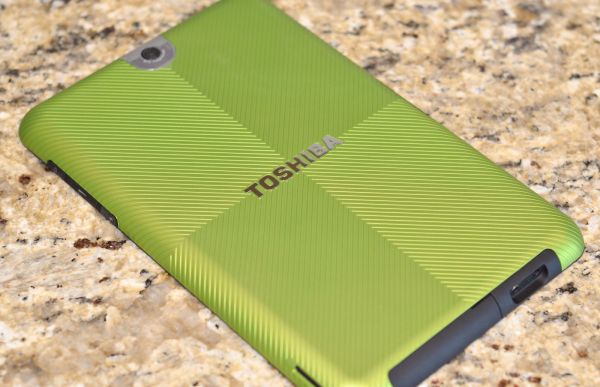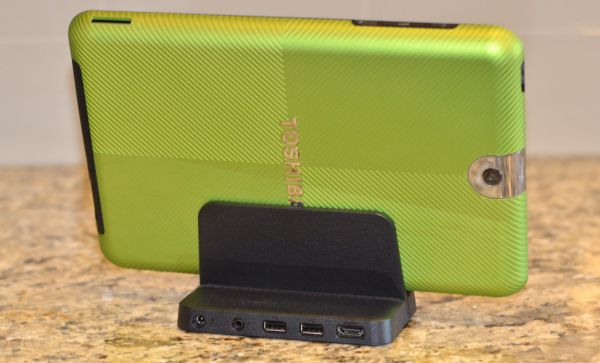Toshiba Thrive: Honeycomb Hits $300
by Vivek Gowri on December 12, 2011 3:00 AM ESTThe Toshiba Thrive has taken a beating from the tech world at large since its introduction during the summer, but I actually like it. Don’t get me wrong, it’s not particularly great, especially when compared to things like the Transformer Prime, the Galaxy Tab 10.1, the Sony Tablet S, etc. At the $399 MSRP (for the 16GB model, 8GB is $379 and 32GB is $479), the flaws are too glaring to overlook—the questionable build quality, the misguided design cues, the general lack of hardware and software polish. But as the price goes down, the Thrive gets more and more attractive. Personally, I think the original Transformer is a better bet than the Thrive, because it’s thinner, has better build quality, and a better screen (IPS panel with Gorilla Glass covering versus the Thrive’s higher contrast ratio, I’ll take the former). With that said, the Thrive isn’t bad at all. I’d say it compares favorably to the Iconia A500, and definitely has its own set of redeeming qualities. I’m a fan of the screen, the rubberized battery cover, the port selection, and the accessibility of the battery (big props to Toshiba for that one).
We’ve seen some low, low prices on Honeycomb tablets this holiday shopping season. At $199, the Thrive is a really, really great buy, though that deal was a Black Friday special that lasted for five minutes before selling out. However, the Thrive and other Honeycomb tablets like the Iconia A500 and the Transformer have been available in the $250-300 range since then. They won’t knock anyone’s socks off, but they offer more than the Kindle Fire (the best regularly priced $200 Android tablet), B&N Nook Tablet, Acer Iconia A100 and other 7” Android tablets that typically go for around $250.
I think at this point, if you’re planning to spend more than $350 on an Android tablet, it’s worth just making the jump to the Transformer Prime. It’s the technological bleeding edge right now, it’s guaranteed an Ice Cream Sandwich update in the very near future, and it basically sets the bar for the next generation of Android tablet hardware. So if you’re buying previous generation hardware, you might as well spend as little as possible, especially when you stop to consider that you get the same basic hardware/software combinations with the lower end devices. Compared to the Galaxy Tab 10.1 (the benchmark first-gen Honeycomb tablet), you lose on the build quality, aesthetics, and ergonomics, as well as giving up some minor camera and screen advantages. If you get the Transformer or Thrive, you’re still getting a more than respectable display panel. But the hardware, software, and basic feature set are all still there.
Now versus the Transformer Prime and other next-gen tablets, it’s a more difficult decision. Without question, you get what you pay for—the Transformer Prime is by far the best and brightest the Android world has to offer at present, and if you’re looking for the fastest and most powerful device, you won’t be satisfied with anything less. But if you’re looking for an inexpensive way to get into tablet computing, an inexpensive Honeycomb tablet like the Thrive is a good way to go.












33 Comments
View All Comments
doggod - Monday, December 12, 2011 - link
How is what Microsoft wants, come into the net books argument at all. None of the tablets people are buying come with a Microsoft OS so you would imagine that manufactures would jump on having net books with android installed which negates any licensing costs.Personally I dont get their use either, apart as a toy. And an expensive toy.
Portability is negated by having to type on the screen( which if you haven't left the tablet down on a surface you have to do one handed)
Websites have to be zoomed to read properly
mathew7 - Tuesday, December 13, 2011 - link
"How is what Microsoft wants, come into the net books argument at all. None of the tablets people are buying come with a Microsoft OS so you would imagine that manufactures would jump on having net books with android installed which negates any licensing costs."Please research before you talk. Just a hint: tablets are not sold with Windows because there is no way to run it. The CPU from the tablets has nothing in common with what you have on a netbook or desktop. It's like diesel vs. gasoline engine: they both take you somewhere, but how they make power is completely different (you cannot run and/or you will damage either engine if you put the wrong fuel).
So tablet designers take no attention to MS Win Starter limitations. But netbook designers, even if the tablet will be sold with Win7 HP, it's still designed for Win7 Starter because of HW sharing between models.
DanNeely - Monday, December 12, 2011 - link
Viewing angles? IPS vs TN?Hrel - Monday, December 12, 2011 - link
I can't beleive someone who reads anandtech has to ask this. TN maxes out at about 170 degree viewing angles, marketed, not practical application. IPS is basically 180 degree, ie you can always see it and it always looks good. IPS has significantly longer response times though. Pretty much all flat panel LCD tv's are IPS.Aloonatic - Monday, December 12, 2011 - link
Why bother to read anandtech at all, when you know everything already?mjcutri - Monday, December 12, 2011 - link
I made the mistake of buying a Thrive for my wife when they first came out in July. It was one of my worst tech purchases ever. I liked the idea of the dock and full size ports, but the flaws just don't make up for what I perceived as advantages.The screen takes next to nothing to break it and Toshiba knows it. They charge over $300 to replace it. Initially you could get a replacement screen and spend 4 hours trying to fix it yourself, but there was such a run on them (since the screen is so crappy) that they ran out of stock quickly. Since then, they have increased the price from $80 to $160 for the replacement screen, which now isn't worth it.
I'm getting her a Transformer when the price drops on those.
mjcutri - Monday, December 12, 2011 - link
Oh yeah, I forgot to mention the incredibly buggy software.The well known problem of not waking from sleep has still not been fixed. (You have to turn it completely off and then back on again.) The screen randomly turn on by itself. (which is really annoying when you're trying to sleep.) The screen randomly doesn't go to sleep when you press the power button. (It just flashes black and then back on again.)
VivekGowri - Monday, December 12, 2011 - link
There was an update to fix the sleep-wake problem, I never encountered it after that...As for the screen, yeah - because it's plastic, it's easier to break/scratch/damage. I really, really wish Toshiba would have gone the extra distance and gone for Gorilla Glass or some other kind of chemically treated glass covering for the screen.mjcutri - Wednesday, December 21, 2011 - link
Yeah...that update...didn't fix crap...And the screen is glass, just not gorilla glass.
TexasAg03 - Monday, December 12, 2011 - link
"...eventually settling in the $4-500 range."Could you please let me know where the $4 tablets are?